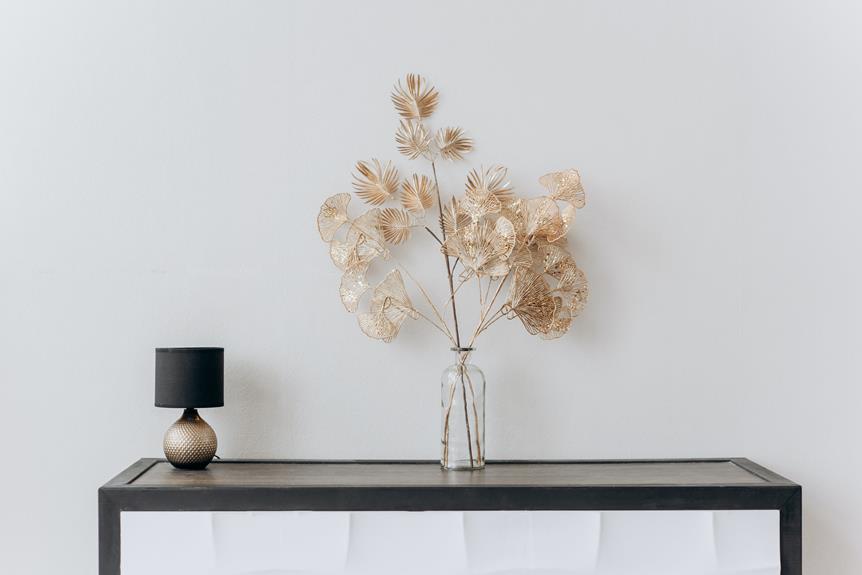So, you've decided your furniture needs a little adventure and wants to take a leap off the wall at any moment?
Let's talk about the simple yet crucial steps to ensure your belongings stay put. From the choice of anchoring hardware to the proper installation technique, there are key factors to consider.
But what about the unexpected challenges that might arise during the process?
Stay tuned to discover how to tackle them and make your furniture feel right at home on the wall.
Importance of Furniture Anchoring
To prevent furniture accidents and ensure household safety, anchoring furniture to the wall is crucial. Securing furniture, especially tall or heavy pieces, can prevent tipping over, which could result in serious injuries or even fatalities. Young children are particularly vulnerable to furniture accidents, as they may try to climb or pull themselves up on unstable pieces. By properly anchoring your furniture, you create a safer environment for everyone in your home.
Not only does anchoring furniture help prevent accidents, but it also adds an extra layer of security during natural disasters like earthquakes or hurricanes. Securing your furniture to the wall can minimize damage and reduce the risk of injury during such events. It's a simple and effective way to protect your loved ones and your belongings.
Take the time to assess your furniture and determine which pieces need to be anchored. Prioritize securing items that are top-heavy or have the potential to tip over easily. By taking this proactive step, you're investing in the safety and well-being of your household.
Choosing the Right Anchoring Hardware
When selecting the appropriate anchoring hardware for your furniture, consider the weight and stability of each piece to ensure proper security. For heavier furniture items such as dressers, bookshelves, or cabinets, opt for sturdy hardware like heavy-duty wall anchors, toggle bolts, or furniture straps. These anchors are designed to withstand the weight and provide a strong hold against the wall. Ensure that the hardware you choose is compatible with the material of your walls; for example, drywall may require different anchors than concrete or plaster walls.
For lighter furniture pieces such as mirrors, frames, or small shelves, smaller anchors like plastic wall plugs or expansion anchors may suffice. These anchors are easier to install and still provide adequate support for securing these items to the wall. When in doubt, always choose hardware that's rated for a weight capacity higher than that of your furniture to guarantee a secure attachment.
Locating Wall Studs for Installation
Consider using a stud finder to accurately locate wall studs before installing anchoring hardware for securing your furniture. Wall studs are essential for providing the necessary support and stability when bolting furniture to the wall. Without securing your furniture to studs, there's a risk of instability and potential damage to both the furniture and the wall.
Stud finders are handy tools that can detect where the studs are located behind the drywall. By running a stud finder along the wall, you can pinpoint the exact placement of the studs and ensure that your anchoring hardware will be attached securely.
When using a stud finder, make sure to follow the manufacturer's instructions carefully. Typically, you'll move the stud finder horizontally across the wall until it indicates the presence of a stud. Marking these locations will guide you in placing your anchoring hardware accurately.
Locating wall studs is a crucial step in preparing to secure your furniture properly, ensuring a safe and stable installation.
Securing Furniture to the Wall
Before securing your furniture to the wall, ensure you have located and marked the wall studs for proper anchoring. Once you have identified the studs, choose the appropriate hardware for your furniture type and the wall material. For heavy or tall furniture pieces, it's recommended to use sturdy brackets or straps along with screws that are long enough to reach the stud.
When attaching the furniture to the wall, make sure to follow the manufacturer's instructions and use all the provided hardware. Position the furniture in its desired location and mark where the brackets or straps will be attached. Drill pilot holes into the studs to prevent splitting, then secure the brackets or straps with the appropriate screws.
After securing the furniture, double-check the attachments to ensure they're tight and properly aligned. It's essential to periodically inspect the connections to guarantee the furniture remains securely fastened to the wall.
Testing the Stability of Anchored Furniture
To ensure the safety of your household, test the stability of anchored furniture by applying gentle pressure in various directions. Begin by gently pushing the furniture from the top to check if it sways or tips over.
Applying pressure sideways can reveal any weak points in the anchoring. Ensure to test both the top and sides of the furniture as some pieces may be more stable in one direction than another.
Additionally, try pulling the furniture forward to see if it stays firmly in place or if it moves easily. If you notice any wobbling or instability, reinforce the anchoring or seek professional assistance to secure the furniture more effectively.
Regularly testing the stability of your anchored furniture is crucial in preventing accidents and ensuring the safety of your household members. Remember, a few minutes devoted to testing can prevent potential hazards in the future.
Frequently Asked Questions
How Often Should Furniture Anchoring Hardware Be Checked and Replaced?
To keep your furniture secure, check anchoring hardware annually. Look for signs of wear or damage. Replace parts as needed. Your safety matters, so don't skip this important maintenance task. It's quick and easy!
Can Furniture Be Safely Anchored to All Types of Walls, Such as Drywall or Plaster?
You can safely anchor furniture to various walls, like drywall or plaster. Consult manufacturer guidelines for suitable hardware. Remember to check and replace anchoring hardware periodically for optimal safety. Follow instructions diligently to secure your furniture.
Are There Any Alternatives to Anchoring Furniture to the Wall for Those Who Are Renting or Unable to Drill Into the Wall?
If you can't anchor furniture to the wall, try anti-tip furniture straps. They secure items like dressers to prevent tipping. Velcro straps or corner braces are other options. Remember, safety first when it comes to securing furniture!
Is It Necessary to Anchor All Furniture to the Wall, or Are There Certain Types of Furniture That Are More Important to Secure?
When securing furniture, prioritize tall, top-heavy pieces like bookcases and dressers. These items are more likely to tip over and pose a safety hazard. Anchoring all furniture is ideal for overall safety in your home.
How Can I Ensure That the Furniture Anchoring Hardware Is Installed Correctly and Securely?
To ensure furniture anchoring hardware is installed correctly and securely, always follow manufacturer instructions, use appropriate tools, check for studs, and tighten bolts firmly. Double-check for stability and make adjustments as needed for added safety.
Conclusion
Now that you have learned how to securely bolt your furniture to the wall, you can have peace of mind knowing that your belongings are safe from tipping over.
By following these simple steps, you can prevent accidents and keep your home secure. Remember to always use the appropriate anchoring hardware and locate wall studs for maximum stability.
Stay safe and keep your furniture anchored!








